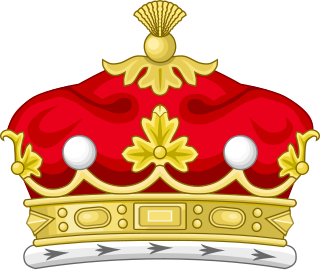
Marquess of Donegall is a title in the Peerage of Ireland held by the head of the Chichester family, originally from Devon, England. Sir John Chichester sat as a Member of Parliament and was High Sheriff of Devon in 1557. One of his sons, Sir Arthur Chichester, was Lord Deputy of Ireland from 1605 to 1616. In 1613, he was raised to the Peerage of Ireland as Baron Chichester, of Belfast in County Antrim. When he died childless in 1625 the barony became extinct.

Viscount Massereene is a title in the Peerage of Ireland. It was created in 1660, along with the subsidiary title of Baron Loughneagh. From 1665 to 1816 the Skeffington Baronetcy of Fisherwick was attached to the viscountcy and from 1756 to 1816 the Viscounts also held the title of Earl of Massereene. Since 1843 the peerages are united with titles of Viscount Ferrard, of Oriel and Baron Oriel, both in the Peerage of Ireland, and Baron Oriel, in the Peerage of the United Kingdom. The Viscount also holds the subsidiary titles of Baron Loughneagh (1660) and Baron Oriel (1790) in the Peerage of Ireland and Baron Oriel (1821) in the Peerage of the United Kingdom. As Baron Oriel, he sat in the House of Lords until 1999.

Major-General Arthur Chichester, 3rd Earl of Donegall was an English Army officer and peer.

Antrim is a town and civil parish in County Antrim, Northern Ireland. It lies on the banks of the Six Mile Water on the north-east shore of Lough Neagh. It had a population of 25,606 people in the 2021 census. It is the county town of County Antrim and was the administrative centre of Antrim Borough Council until its 2015 merger with Newtownabbey Borough Council to form Antrim and Newtownabbey Borough Council. The town lies 14 miles (23 km) north-west of Belfast.

John Clotworthy, 1st Viscount Massereene was a prominent Anglo-Irish politician.

Belfast Castle is a mansion located in Cave Hill Country Park in Belfast, Northern Ireland, in a prominent position 400 feet (120 m) above sea level. Its location provides unobstructed views over the City of Belfast and Belfast Lough. There have been several structures called "Belfast Castle" over the centuries, located on different sites. The current "castle" is a Victorian structure, built between 1867 and 1870 on the slopes of Cave Hill, and is Grade A listed. The main entrance into the Belfast Castle Demesne is now where Innisfayle Park meets Downview Park West, just off the Antrim Road. The original main entrance into the current demesne was formerly on the Antrim Road itself, where Strathmore Park now meets the Antrim Road.
The Battle of Antrim was fought on 7 June 1798, in County Antrim, Ireland during the Irish Rebellion of 1798 between British troops and Irish insurgents led by Henry Joy McCracken. The British won the battle, beating off a rebel attack on Antrim town following the arrival of reinforcements but the county governor, John O'Neill, 1st Viscount O'Neill, was fatally wounded.
John Clotworthy Talbot Foster Whyte-Melville-Skeffington, 13th Viscount Massereene and 6th Viscount Ferrard DL was a British politician and landowner. He was also Baron of Loughneagh, 6th Baron Oriel, and 6th Baron Oriel, and served as a Deputy Lieutenant for County Antrim. He succeeded his father in 1956 and regularly attended the House of Lords.

Killyleagh Castle is a castle in the village of Killyleagh, County Down, Northern Ireland. It is believed to be one of the oldest inhabited castles in the country, with parts dating back to 1180. It follows the architectural style of a Loire Valley château, being redesigned by the architect Sir Charles Lanyon in the mid-19th century. It has been owned by the Hamilton family since the early 17th century.
County Antrim was a constituency represented in the Irish House of Commons until 1800.
Newtownards was a constituency represented in the Irish House of Commons until 1800.
Algernon William John Clotworthy Skeffington, 12th Viscount Massereene and 5th Viscount Ferrard, DSO was a British Army officer and an Ulster Unionist member of the Senate of Northern Ireland from 1921 to 1929. During this period he served as Deputy Leader of the Senate and Parliamentary Secretary in the Department of the Prime Minister.

Summerhill House was a 100-roomed Palladian house in County Meath, Ireland which was the ancestral seat of the Viscounts Langford and the Barons Langford. Built in 1731, it was likely designed by Sir Edward Lovett Pearce and completed by Richard Cassels in the Palladian style, although Sir John Vanbrugh, who was related to Pearce and with whom he trained, is thought to have also influenced the design of the house, which could be seen by the Baroque details, great arched chimney stacks and the palatial grandeur and scale.
Henry Skeffington, 3rd Earl of Massereene was an Anglo-Irish British Army officer, politician and peer.
Chichester Clotworthy Skeffington, 4th Earl of Massereene was an Anglo-Irish politician and peer.
Hercules Langford Rowley PC was an Irish politician and landowner.
Clotworthy is a surname derived from Clotworthy near Wembworthy, Devon, England. The family inherited the manor of Rashleigh in Wembworthy in the 16th century. Sir Hugh Clotworthy (1569–1630) gained land in Ireland in the Plantation of Ulster and built Antrim Castle there. Clotworthy was used as a given name by his descendants.
John Skeffington, 2nd Viscount Massereene was an Anglo-Irish politician, official, and peer. He was one of the leading Presbyterians in Ireland during his lifetime.
Clotworthy Skeffington, 3rd Viscount Massereene was an Anglo-Irish soldier, politician and peer.
Hercules Rowley was an Anglo-Irish politician.











